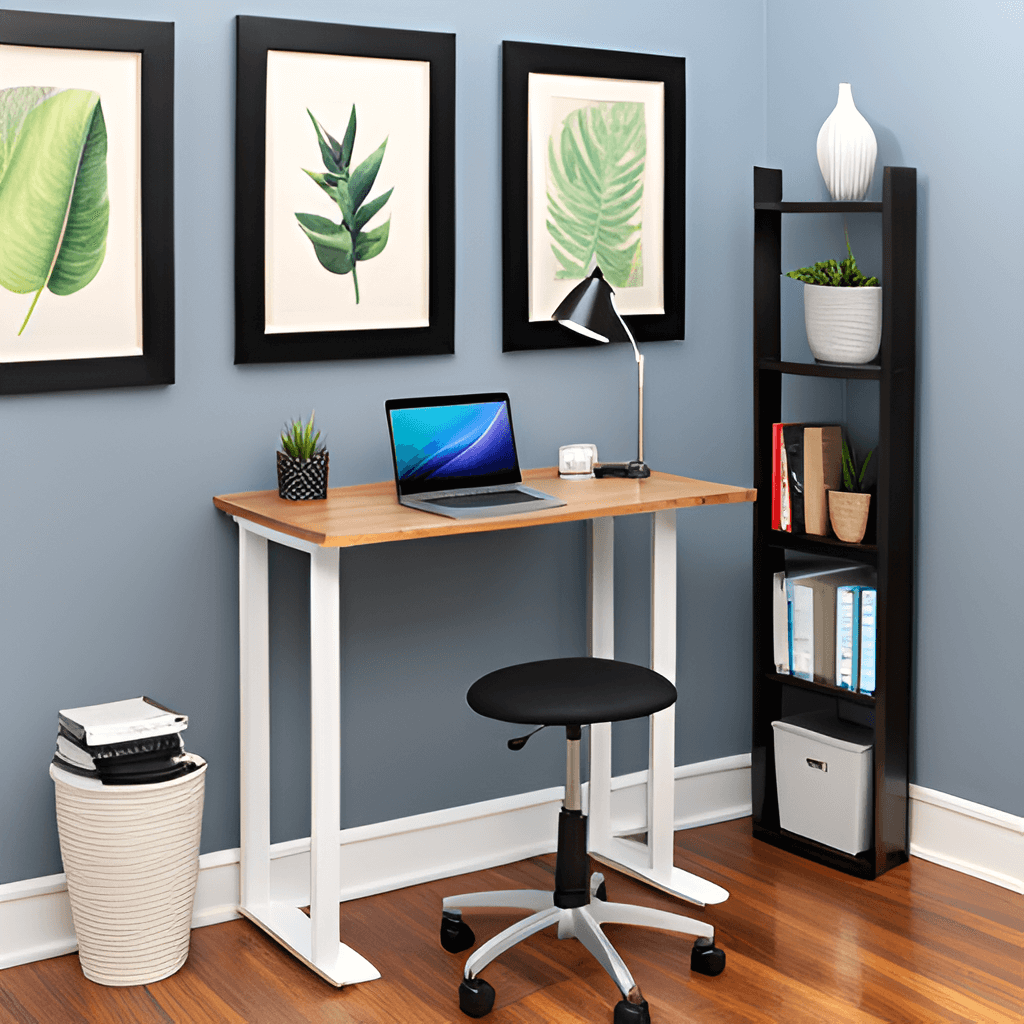
Standing Desk for Small Spaces: Ergonomic Essentials and Setup Tips
| Key Takeaways |
|---|
| – Choose a small space standing desk that fits your available area and complements your decor. |
| – Prioritize ergonomic essentials, including proper desk height, monitor placement, and cable management. |
| – Consider using an anti-fatigue mat to reduce fatigue during prolonged standing. |
| – Personalize your setup with accessories like a footrest or standing desk converter for added comfort. |
| – Maintain and care for your standing desk to ensure its longevity and functionality. |
| – Troubleshoot common issues like cable clutter and discomfort by making necessary adjustments. |
| – Regularly take breaks to stretch and move around, promoting better circulation and overall well-being. |
| – Stay organized and declutter your workspace to optimize your small space standing desk setup. |
| – Small space standing desks can be used effectively in shared or communal areas of your home. |
| – Small space standing desks offer ergonomic benefits, promoting improved posture and increased energy levels. |
Introduction
Welcome to Opvital, your trusted source for work-life and productivity advice. If you’re one of the many individuals looking for a standing desk for small spaces, you’re in the right place. In this article, we’ll delve into the world of small space standing desks and provide you with the knowledge you need to create a comfortable and ergonomic setup.
I. Why Choose a Small Space Standing Desk
Before we dive into the nitty-gritty of setting up your standing desk for small spaces, let’s understand why this choice is beneficial. Check our article on Standing Desk Pros and Cons.
Benefits of a Standing Desk in Limited Space
| Benefit | Description |
|---|---|
| Improved Posture | Sitting for extended periods can lead to poor posture and discomfort. A small space standing desk encourages better alignment, reducing the risk of back and neck pain. |
| Increased Energy | Standing promotes blood circulation and can help combat midday fatigue, keeping you more alert and focused. |
| Enhanced Productivity | Many individuals find that they’re more productive when they can switch between sitting and standing throughout the day. |
II. Choosing the Right Small Space Standing Desk
Now that you’re convinced of the advantages, let’s explore how to select the perfect standing desk for small spaces. If you’re wondering about the different types available, explore our guide on Types of Standing Desks: Electric vs. Manual.
Key Considerations
- Size and Dimensions: Measure your available space carefully. Look for desks designed to fit snugly into small areas without overwhelming the room.
- Adjustable Height Options: Opt for a desk with adjustable height settings to accommodate different users and ensure ergonomic comfort.
- Style and Design: Choose a desk that complements your existing décor. Compact standing desks for small spaces come in various styles, from minimalistic to modern.
Recommendations
- The SHW Small Standing Desk: A sleek, adjustable small space standing desk ideal for home offices.
- The Flexispot Height Adjustable Desk: A compact desk with a minimalist design, perfect for tight spaces.
III. Workspace Preparation
Before the desk arrives, there are essential steps to take to ensure your workspace is ready.
Declutter and Organize

Clear away unnecessary items and create a clean workspace. Remove any obstacles that might hinder the small space standing desk placement.
Optimize the Small Space
Consider using vertical space with wall-mounted storage solutions. Make the most of available wall or corner areas for your standing desk in small spaces.
IV. Ergonomic Essentials for Small Space Standing Desks
Ergonomics is key to a comfortable and healthy work setup, especially with a standing desk for small spaces. For a detailed guide on this, check out our Ergonomic Standing Desk Setup Guide.
Desk Height Adjustment
Adjust the desk’s height so that your elbows are at a 90-degree angle when typing, and your monitor is at eye level. This prevents strain on your wrists and neck. Ensure you get the height right. If you’re unsure, use our Standing Desk Height Calculator.
Monitor Placement and Eye Level
Position your monitor directly in front of you at eye level. Use a monitor stand if needed to achieve the correct height.
Keyboard and Mouse Positioning
Keep your keyboard and mouse at the same height and within easy reach. This prevents awkward wrist angles and discomfort.
Anti-Fatigue Mat Placement
Place an anti-fatigue mat under your desk to reduce fatigue and pressure on your feet, legs, and lower back during prolonged standing.
Cable Management
Keep cables organized and out of the way to prevent tripping hazards and maintain a tidy workspace.
V. Chair vs. Anti-Fatigue Mat
One common question for standing desk users in small spaces is whether to keep a chair nearby or use an anti-fatigue mat.
- Chair: If you have the space, a compact chair can be a valuable addition for occasional sitting breaks.
- Anti-Fatigue Mat: In tight spaces, an anti-fatigue mat is an excellent choice as it provides cushioning and encourages movement while standing.
VI. Personalization and Comfort
Remember, your workspace should cater to your needs. Personalize your small space standing desk setup to make it as comfortable and functional as possible. Here are some tips:
- Use a footrest to shift your weight and reduce leg fatigue.
- Incorporate a standing desk converter to your setup if you prefer flexibility.
- Take regular breaks to stretch and move around, even with a small standing desk.
VII. Troubleshooting Common Issues
As you set up your standing desk for small spaces, you may encounter a few common issues. Let’s address them:
Cable Clutter
Use cable clips and organizers to keep cords neat and prevent them from tangling.
Discomfort
If you experience discomfort, review your ergonomic setup. Make adjustments until you find a comfortable position.
VIII. Maintenance and Care
Taking care of your small space standing desk ensures it will serve you well for years to come.
- Regularly clean the desk surface to prevent dust buildup.
- Lubricate any moving parts to maintain smooth height adjustments.
- Inspect the desk for any loose screws or bolts and tighten them as needed.
Conclusion
Congratulations! You’re now equipped with the knowledge to set up your small space standing desk correctly. If you’re still debating the utility of such desks, read our article: Are Standing Desks Worth It? Remember, ergonomics is the key to a comfortable and productive workspace. Whether you’re in a tiny apartment or a cozy corner of your home, a well-organized and ergonomic standing desk for small spaces can make all the difference. For more tips on improving your work-life and productivity, stay tuned to Opvital.
FAQ’s
While you can technically use a regular-sized standing desk in a small space, it’s not the most practical choice. Compact or small space standing desks are designed to maximize limited space efficiently while maintaining ergonomic comfort. They are generally a better fit for small workspaces.
To determine if a standing desk is suitable for your small space, measure the area where you plan to place the desk. Look for compact models that fit comfortably within those dimensions. Additionally, consider your workspace needs and whether a standing desk aligns with your work habits.
Absolutely! Standing desks can be used in shared workspaces or communal areas. Just ensure that the desk is placed in a way that doesn’t disrupt other activities or hinder the flow of the space when not in use.
Accessories can enhance your standing desk experience, but they are not always necessary. For a basic setup, all you need is a small space standing desk itself. However, accessories like cable organizers, anti-fatigue mats, and monitor stands can improve ergonomics and organization.
Read More
- Digital Marketing Tools: The Importance of Marketing Tools
 The Importance of Marketing Tools In today’s digital landscape, businesses …
The Importance of Marketing Tools In today’s digital landscape, businesses …Digital Marketing Tools: The Importance of Marketing Tools Read More »
- A Guide to Fundamental Marketing Tools for Businesses
 What are marketing tools? At Opvital, we’re dedicated to shedding …
What are marketing tools? At Opvital, we’re dedicated to shedding …A Guide to Fundamental Marketing Tools for Businesses Read More »
- The Significance of Marketing Tools
 Key Takeaways for Marketing Tools Marketing Tools Overview – Diverse …
Key Takeaways for Marketing Tools Marketing Tools Overview – Diverse … - A Comprehensive NeuronWriter Review: Unveiling Its SEO Powers
 Welcome to Opvital’s in depth NeuronWriter Review. NeuronWriter is more …
Welcome to Opvital’s in depth NeuronWriter Review. NeuronWriter is more …A Comprehensive NeuronWriter Review: Unveiling Its SEO Powers Read More »
